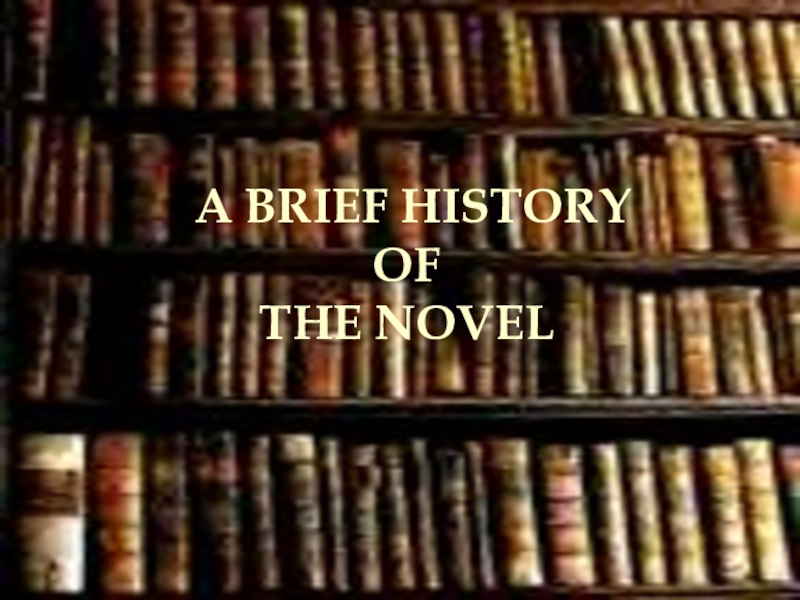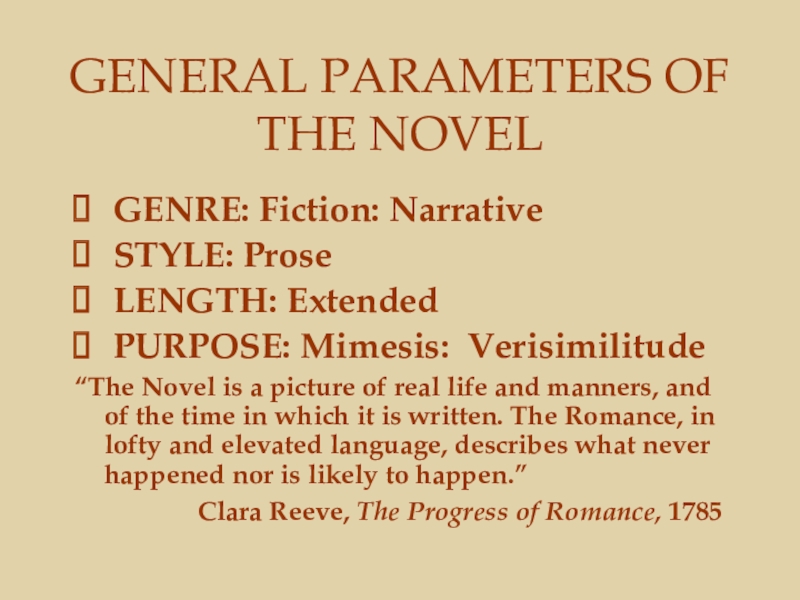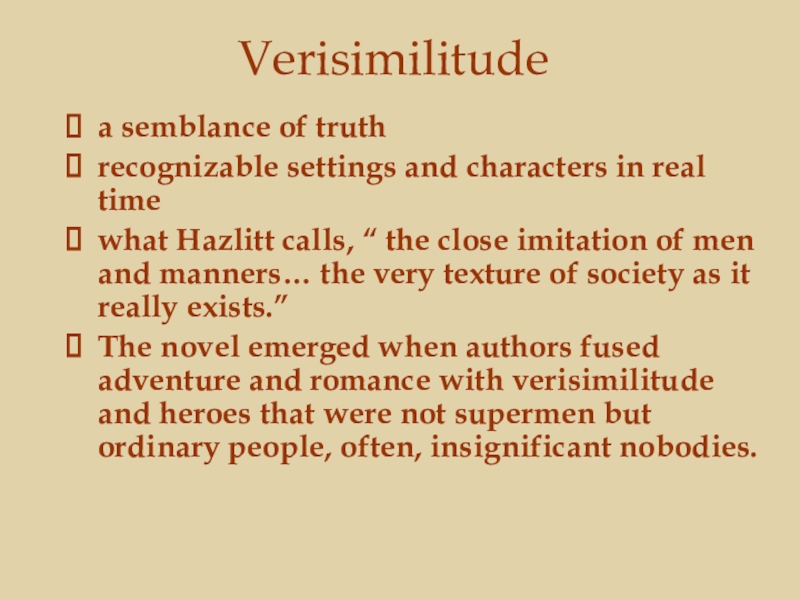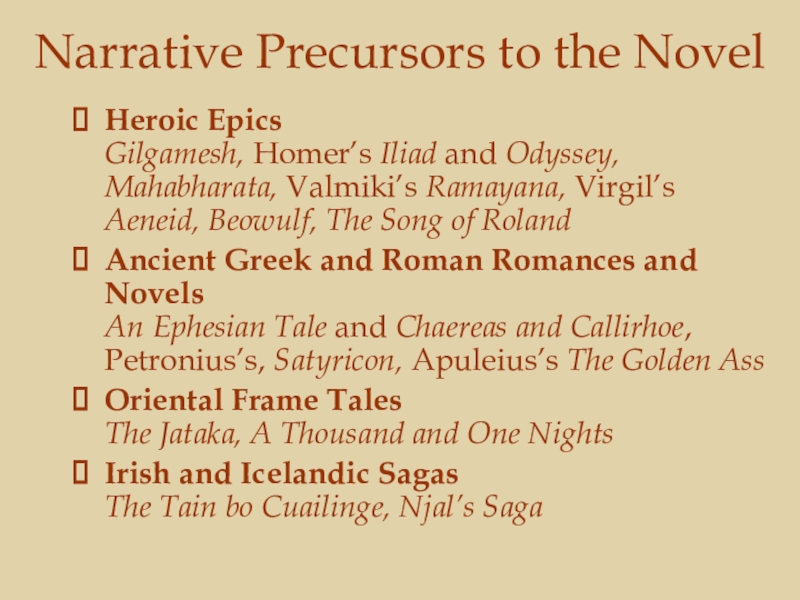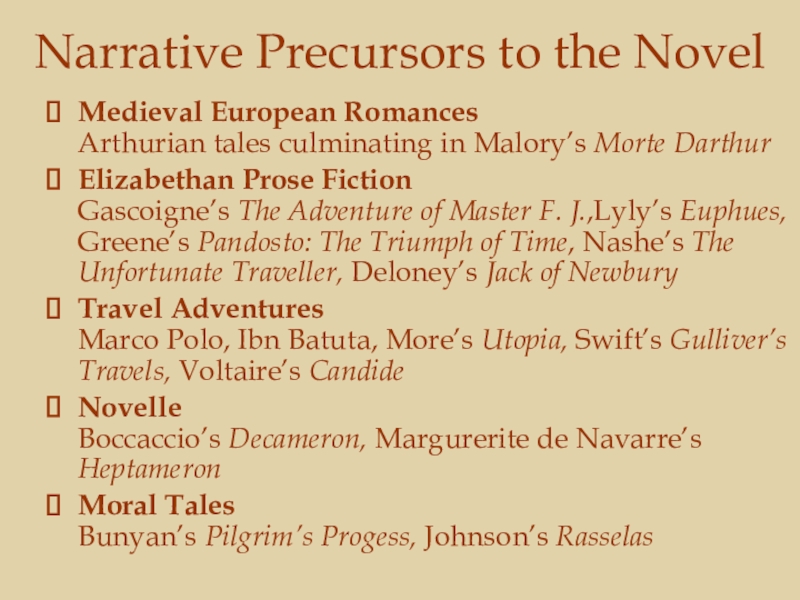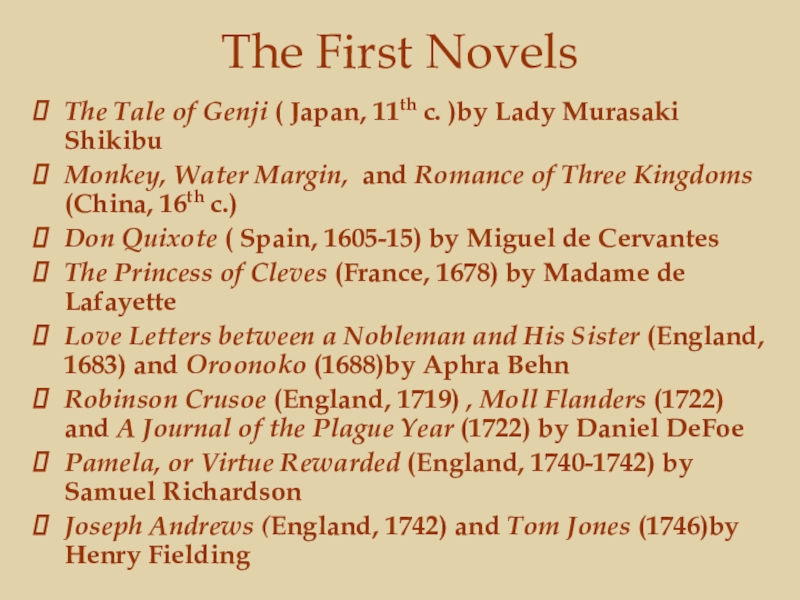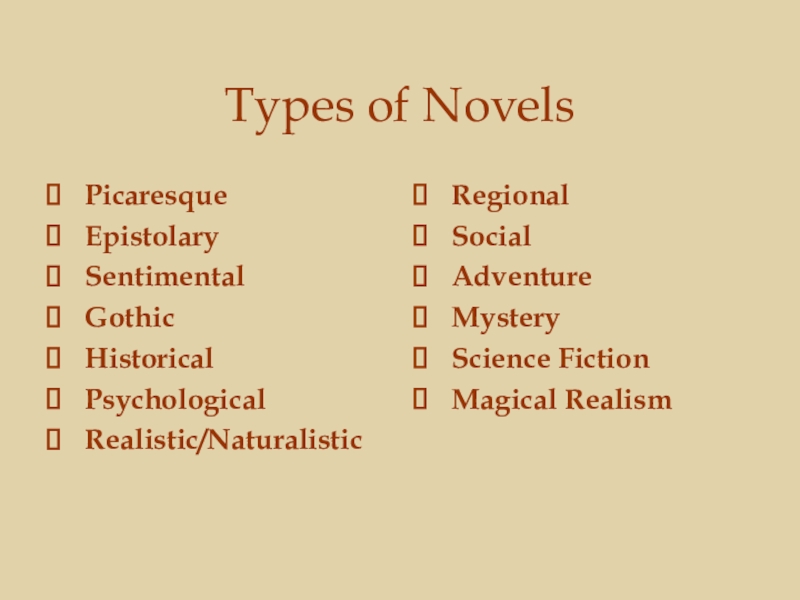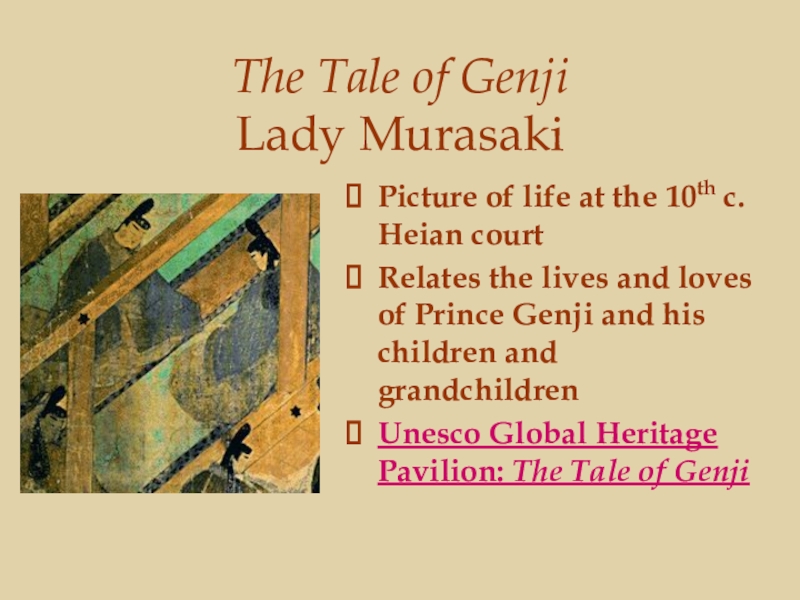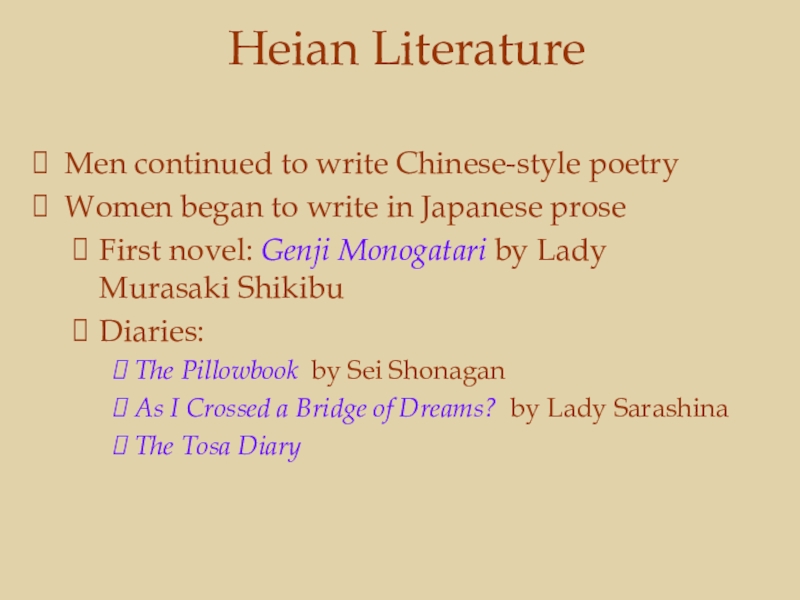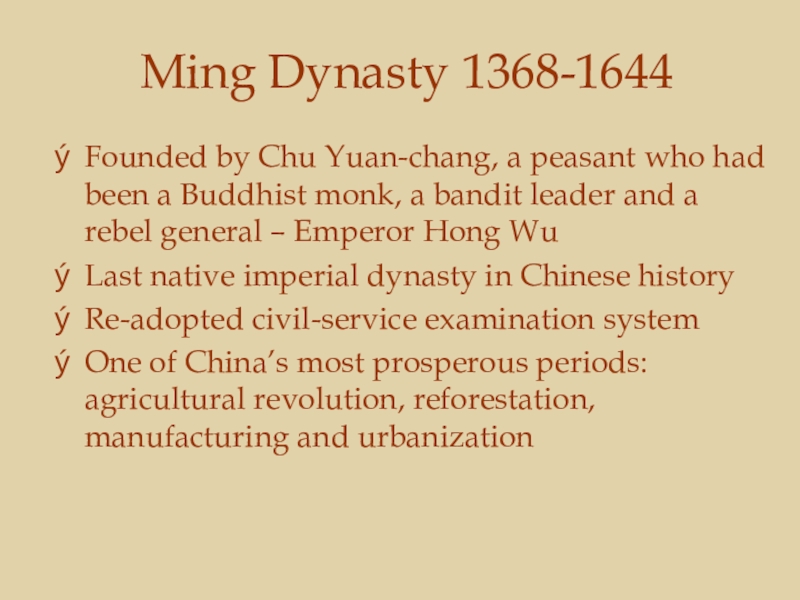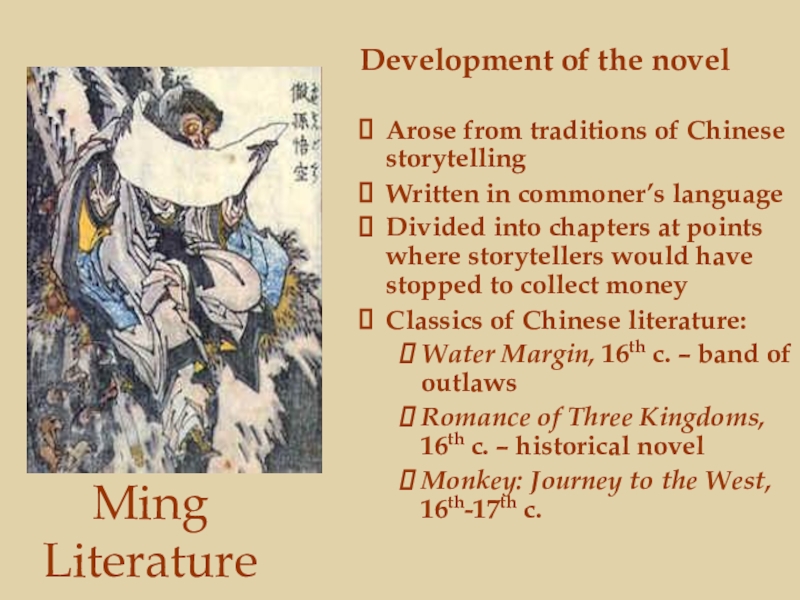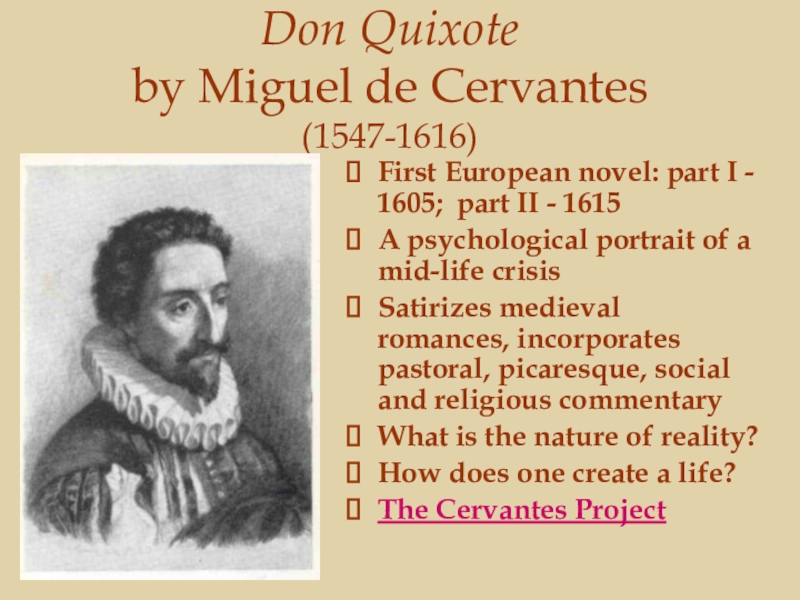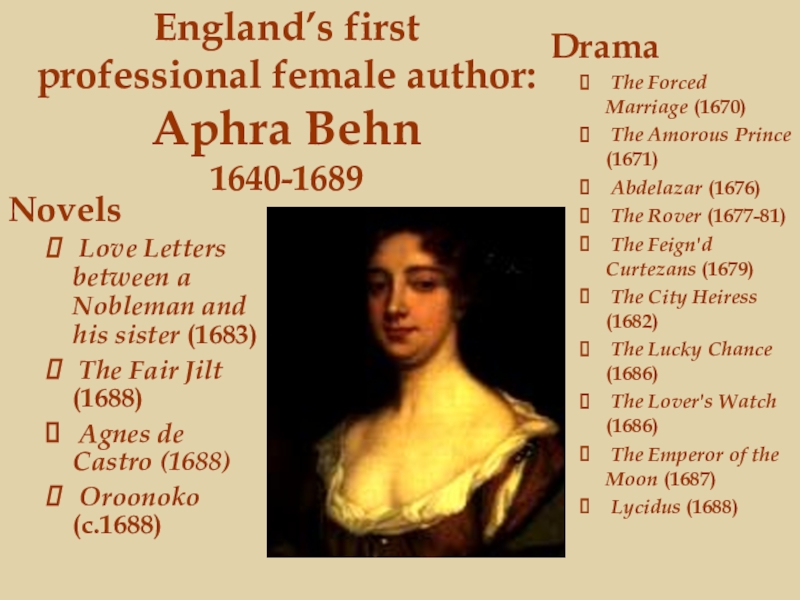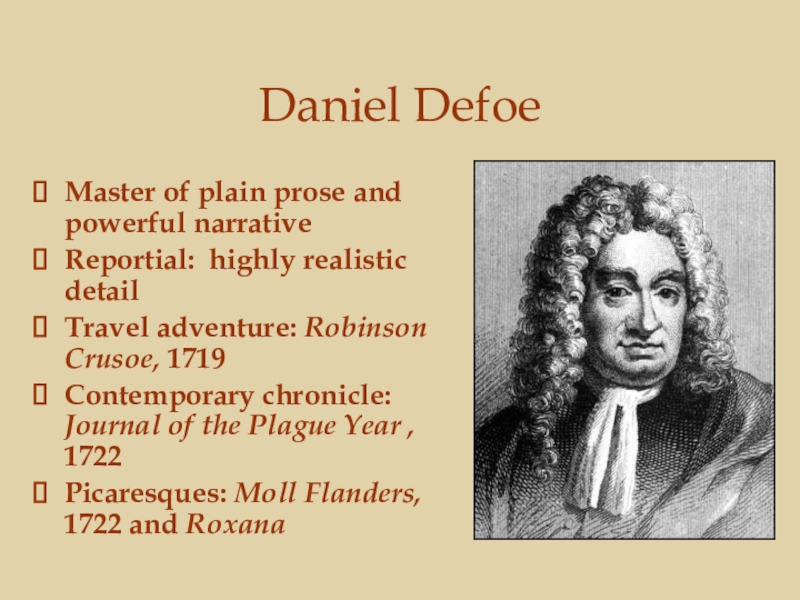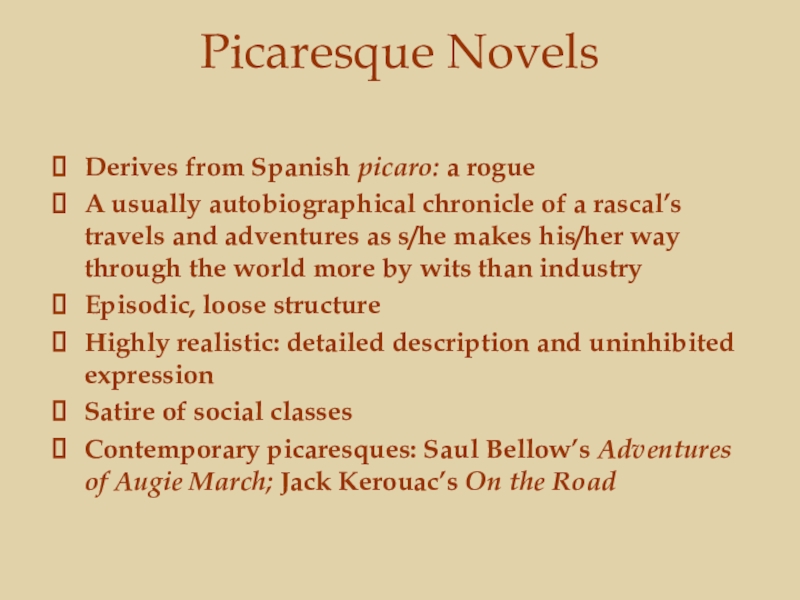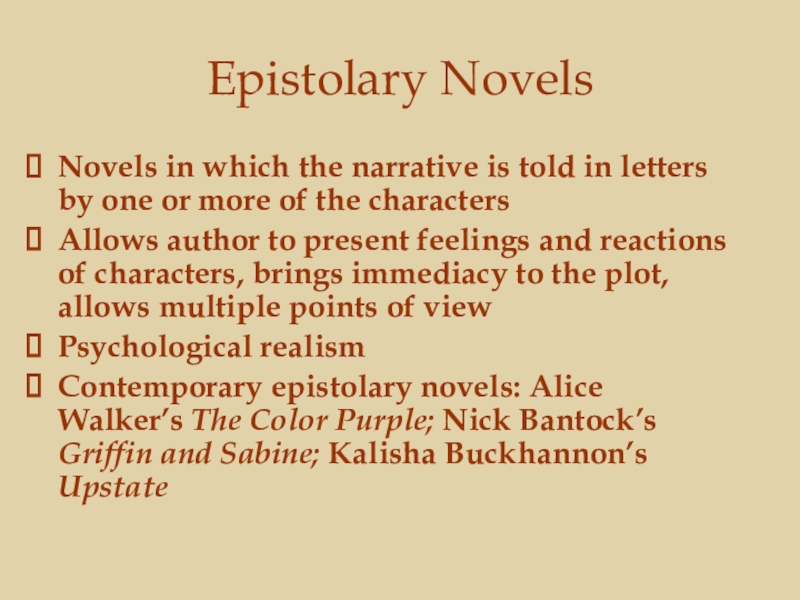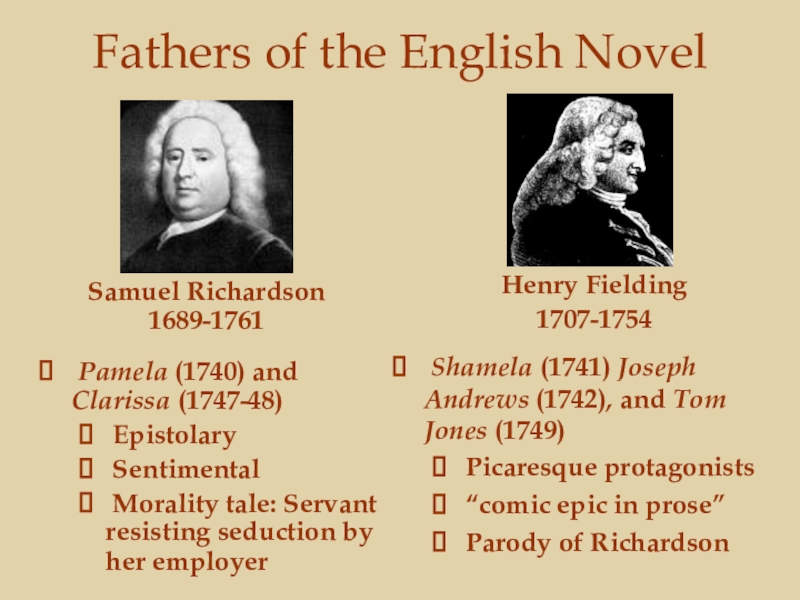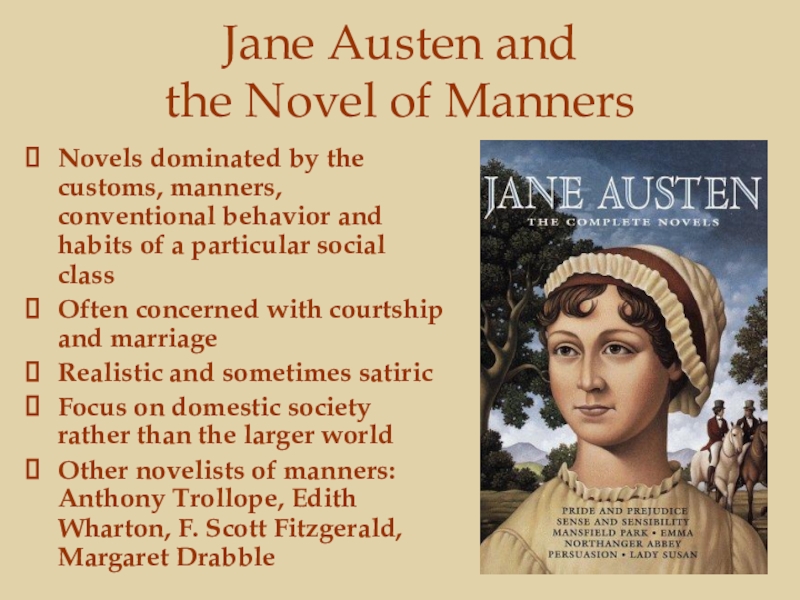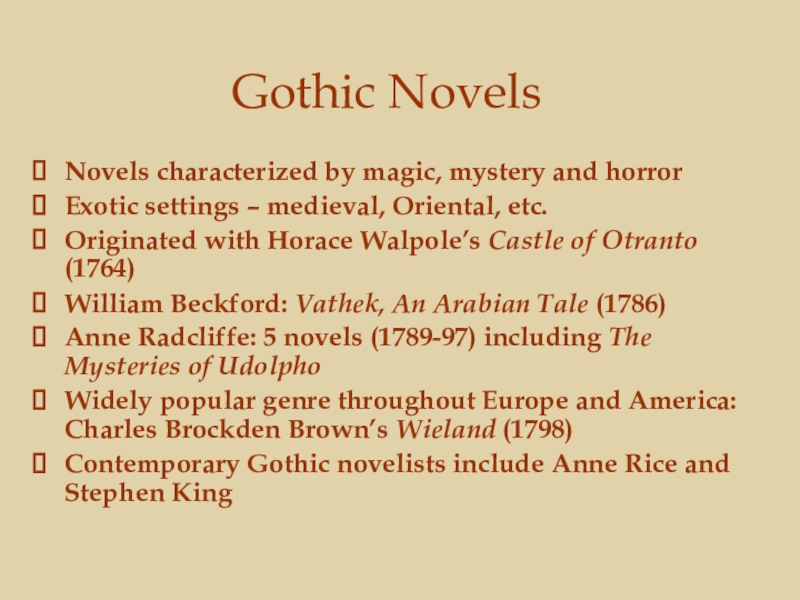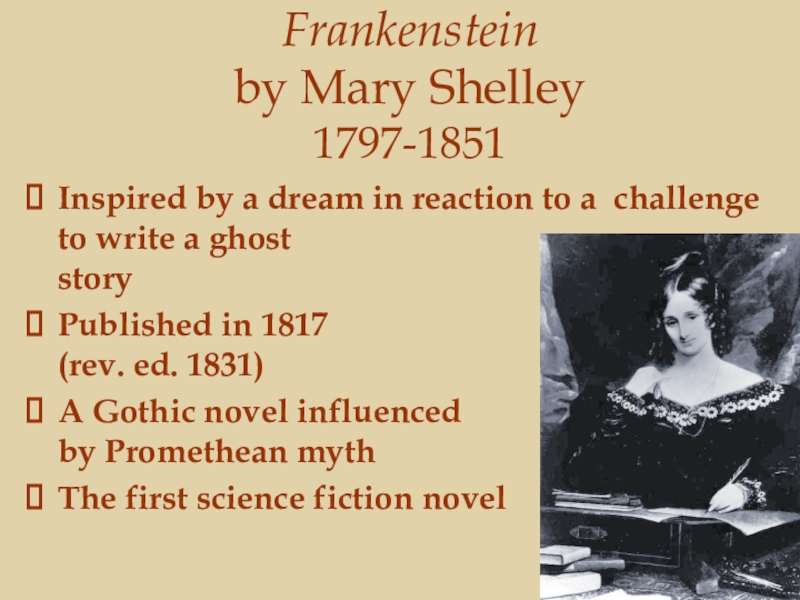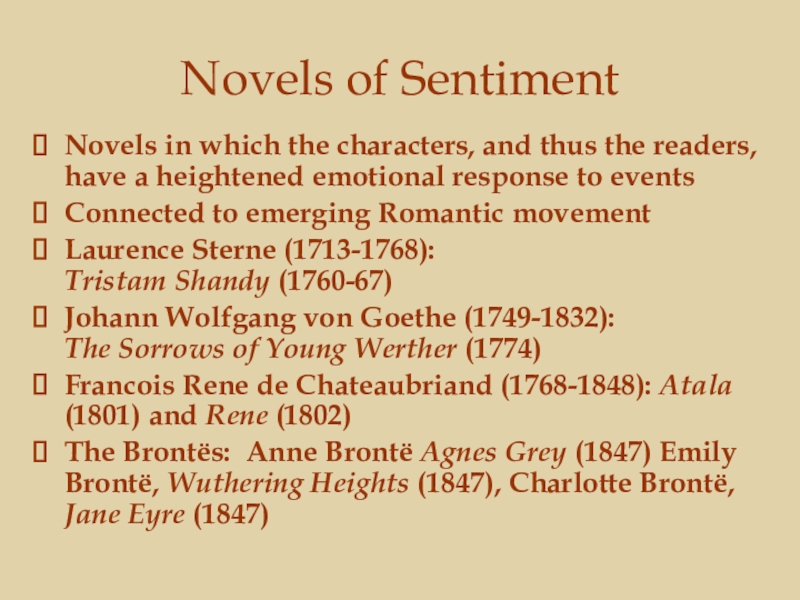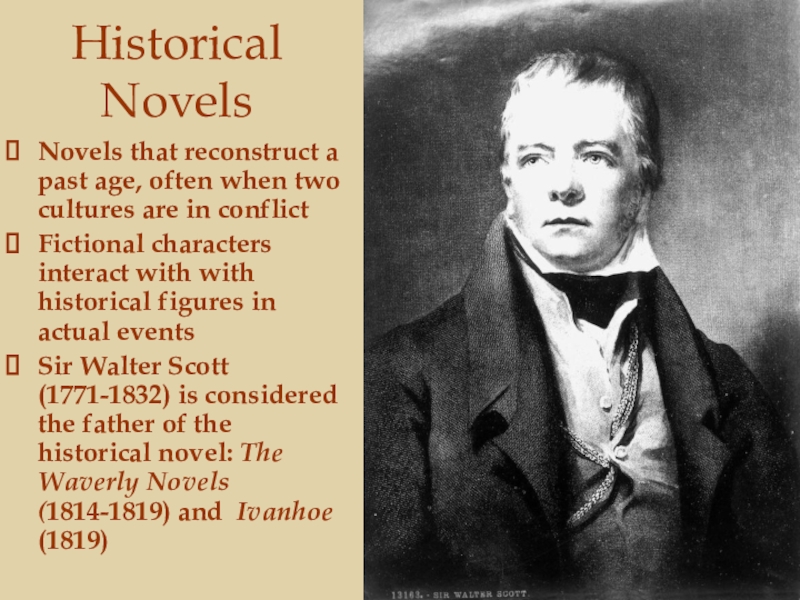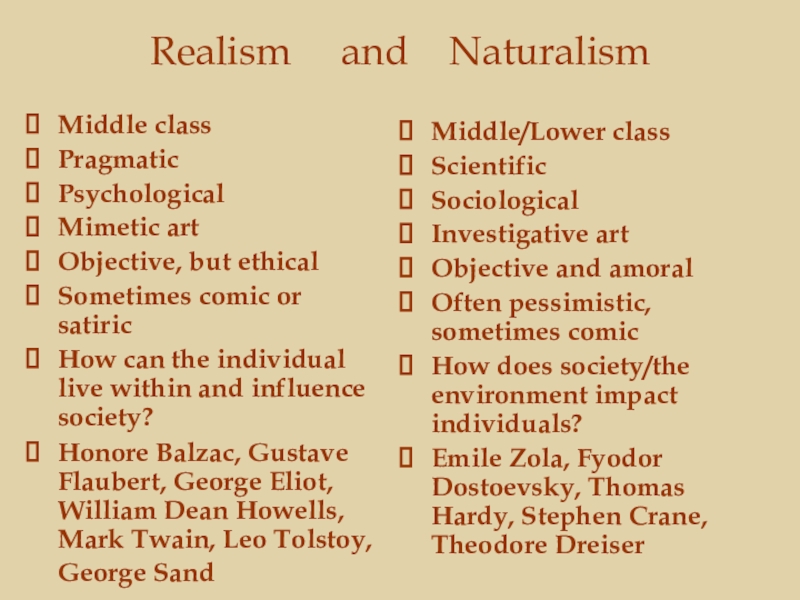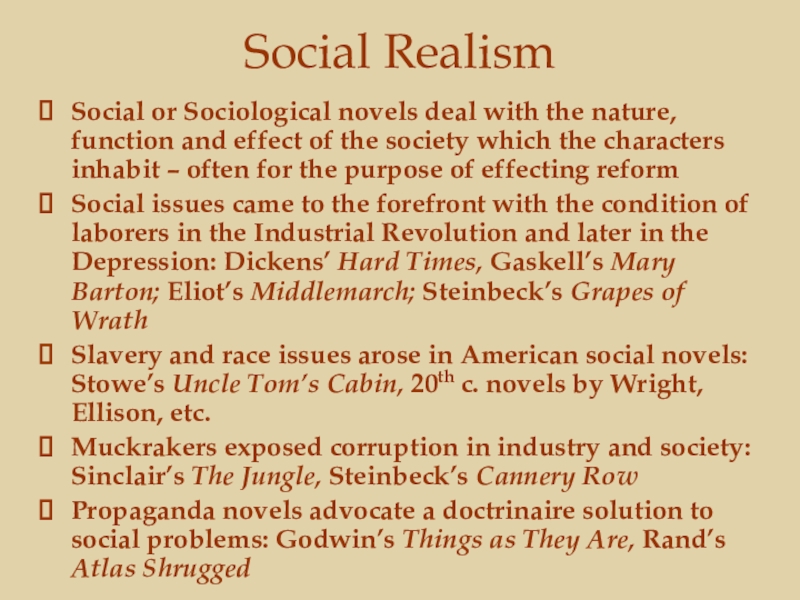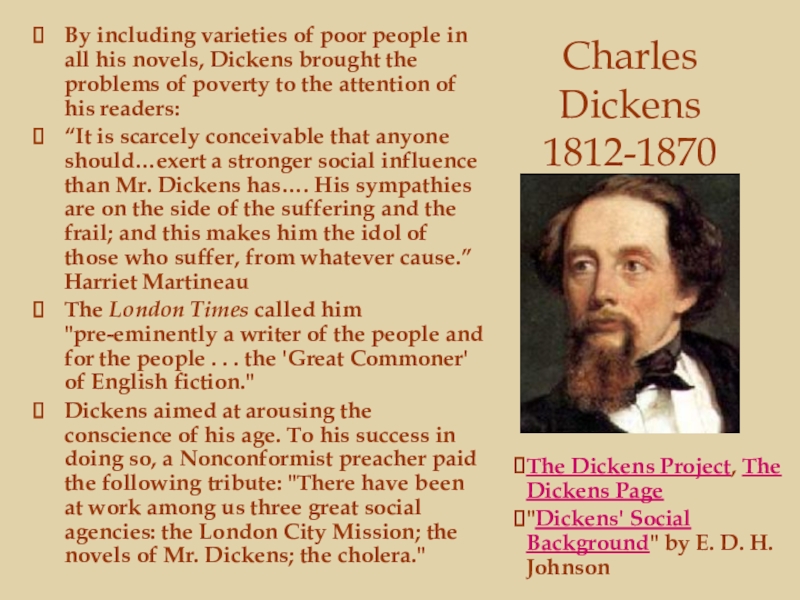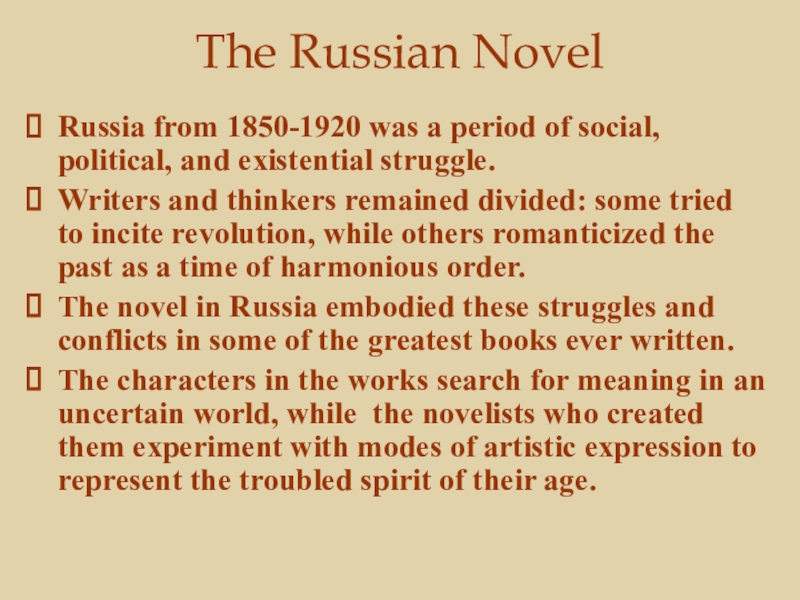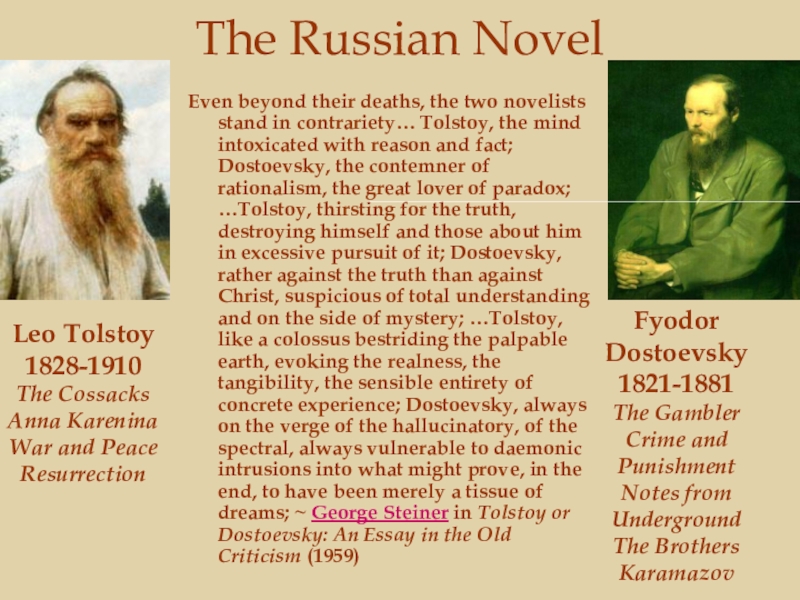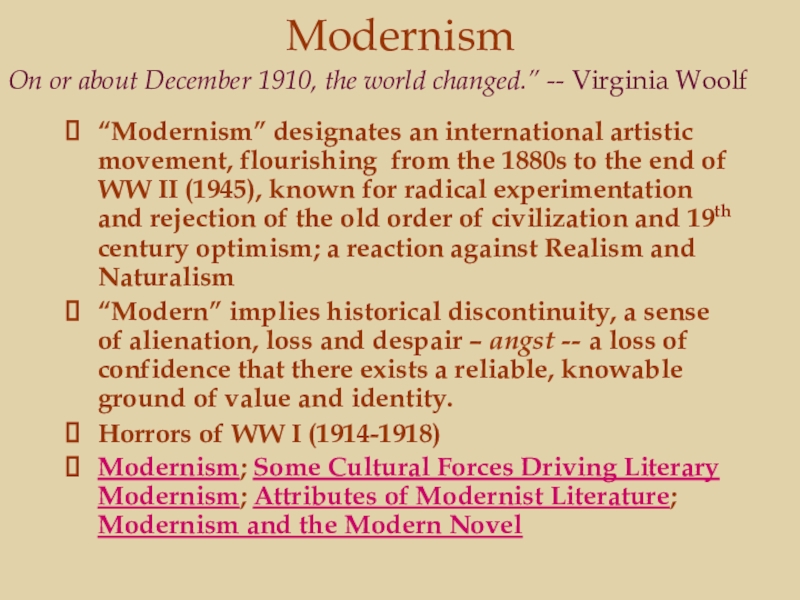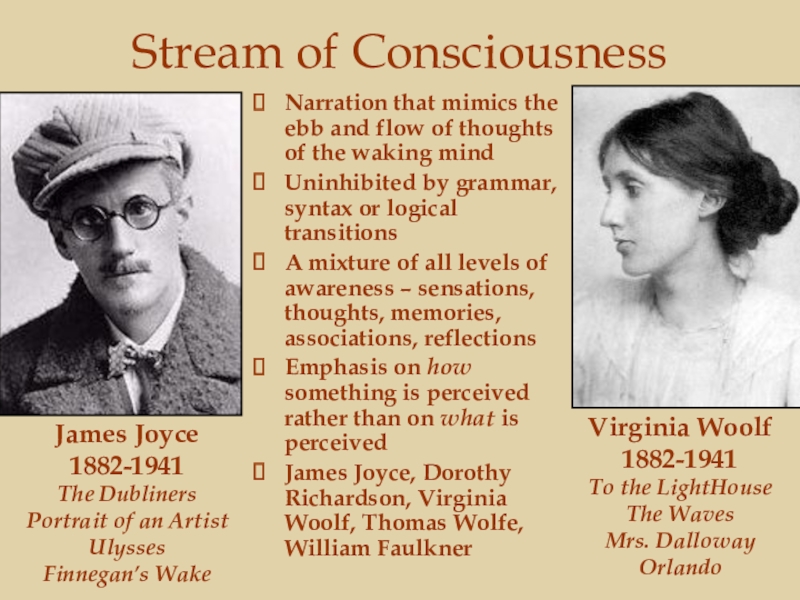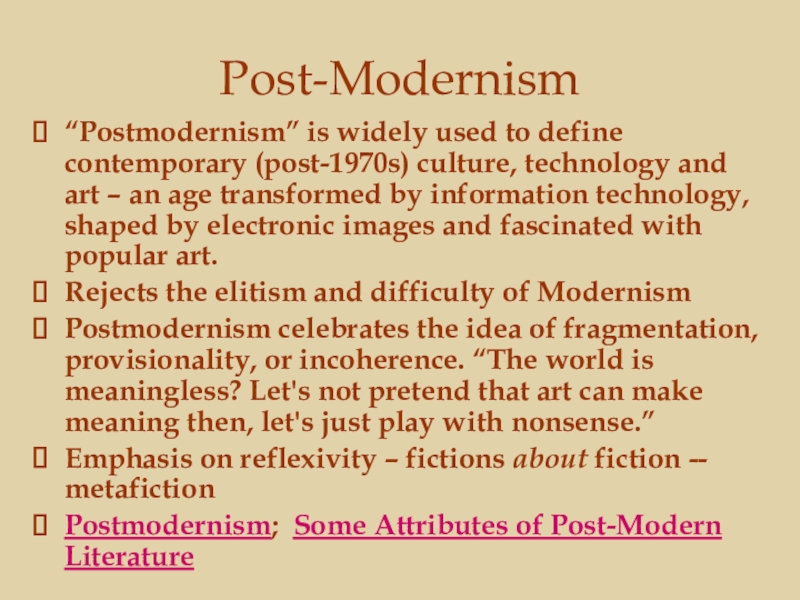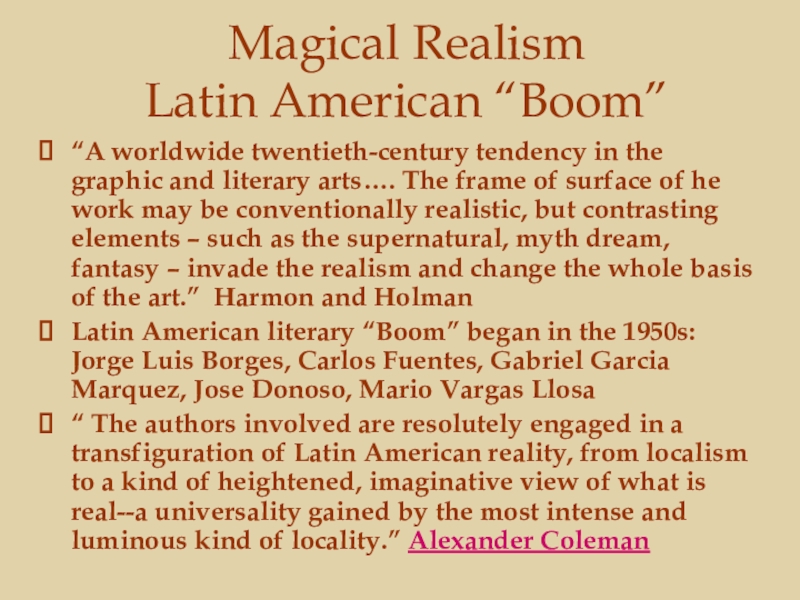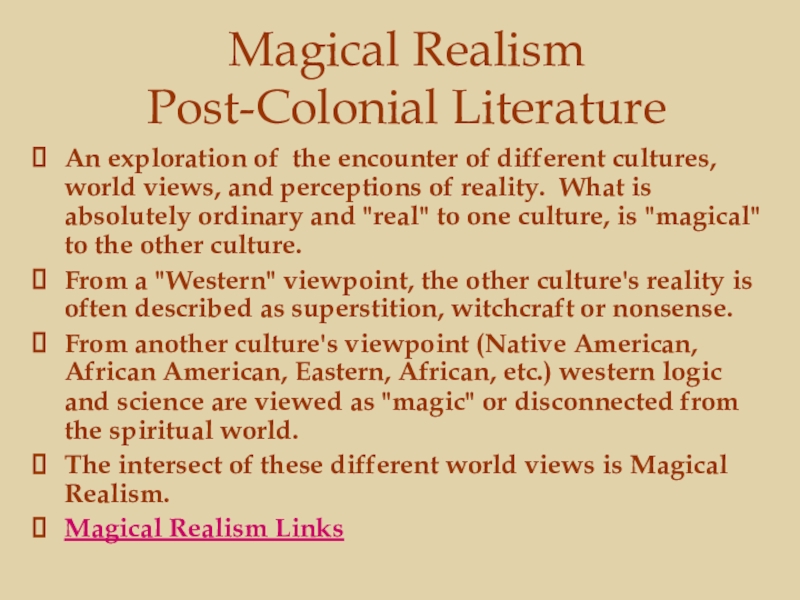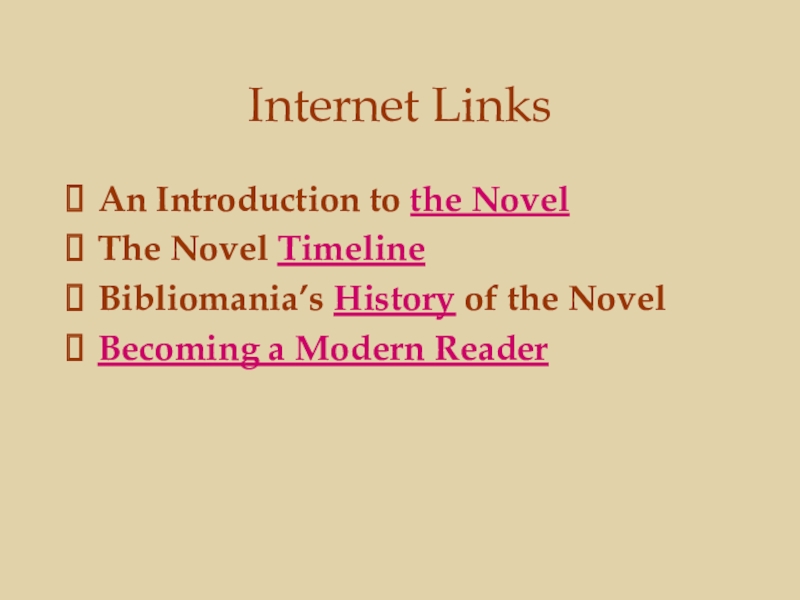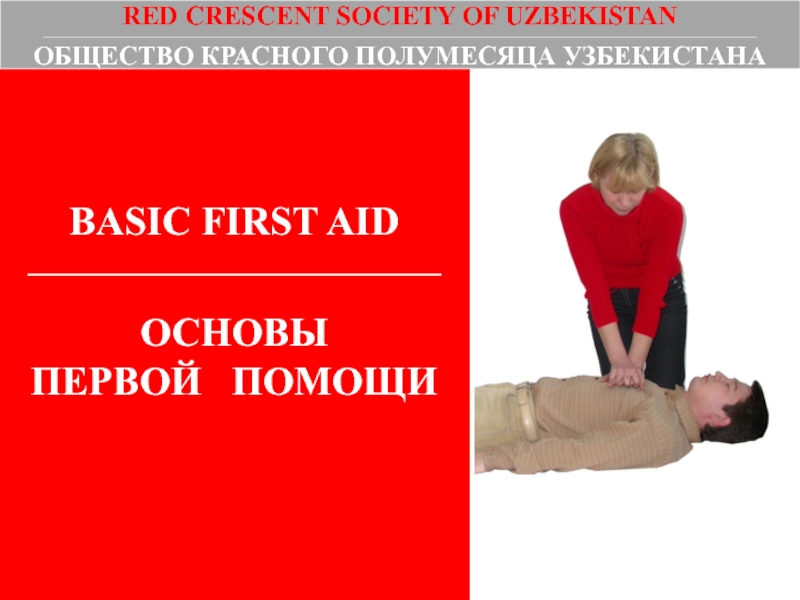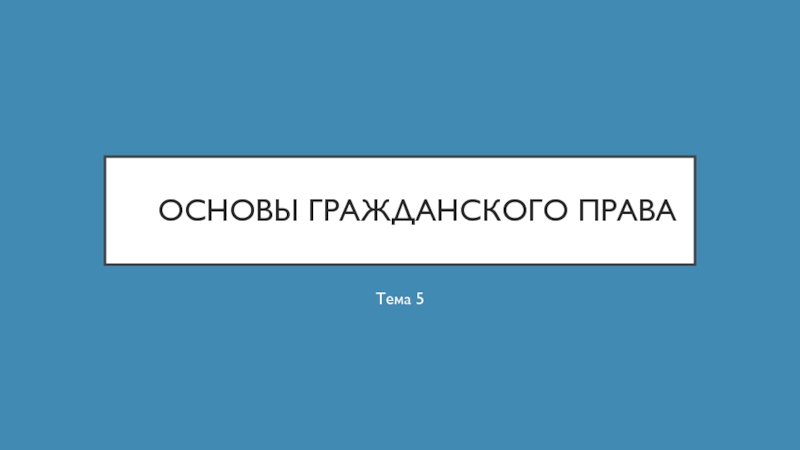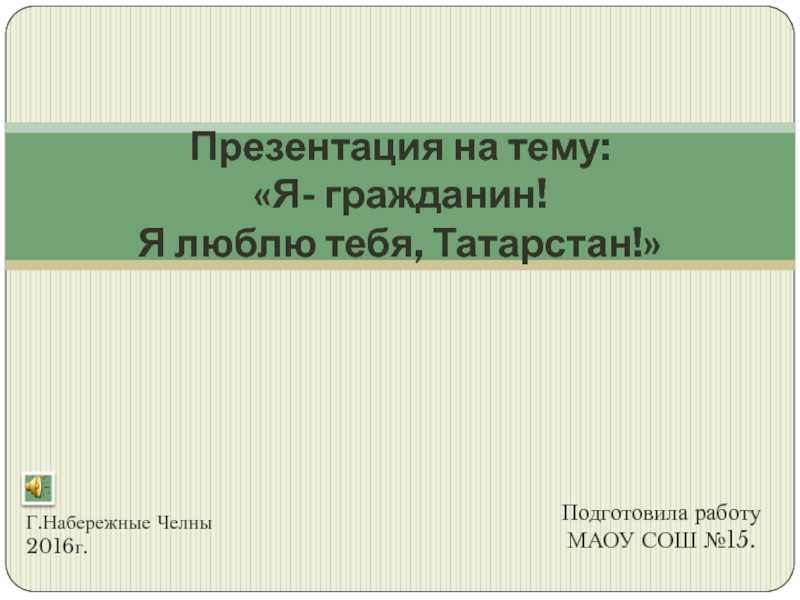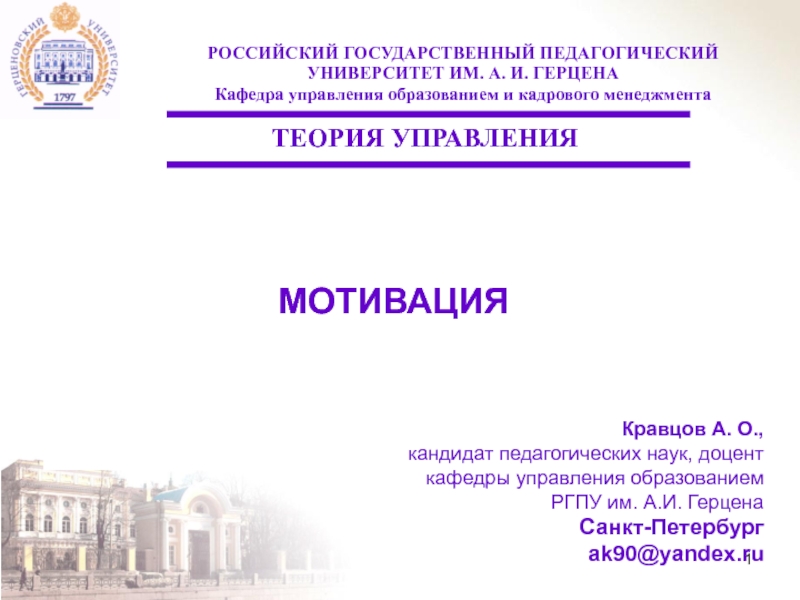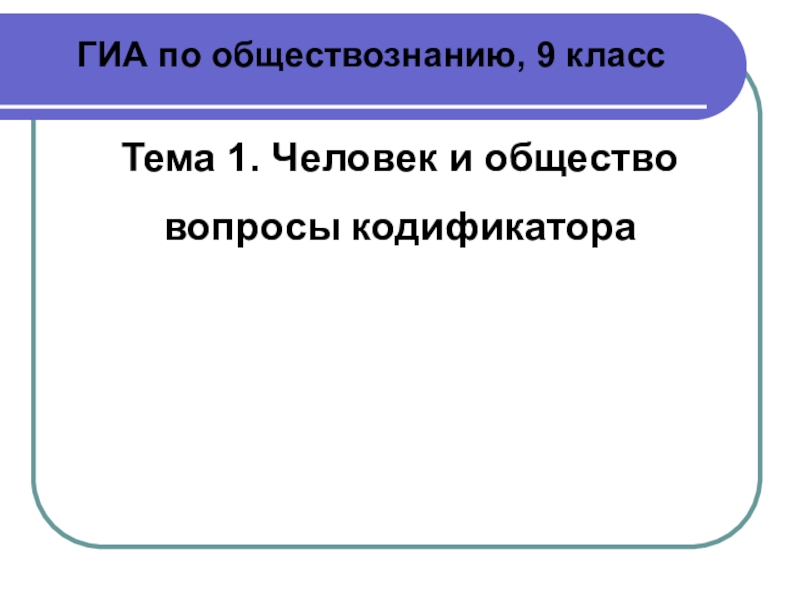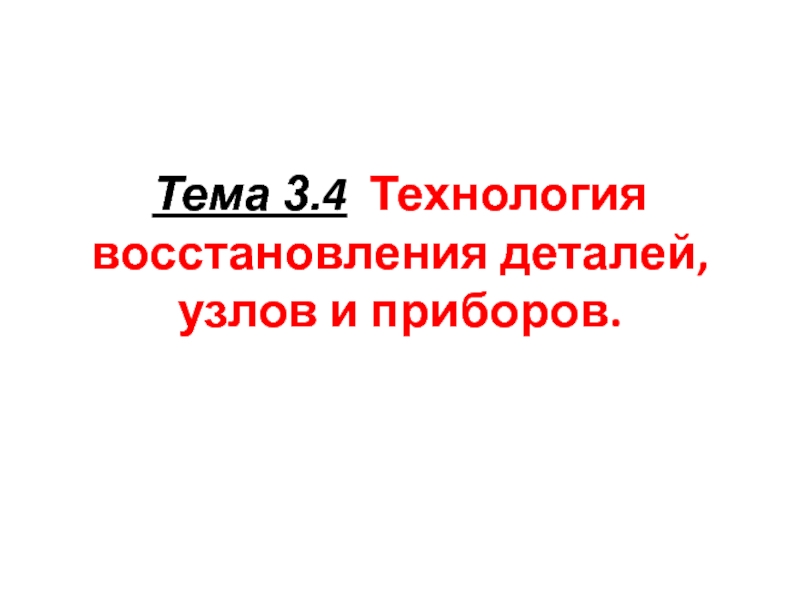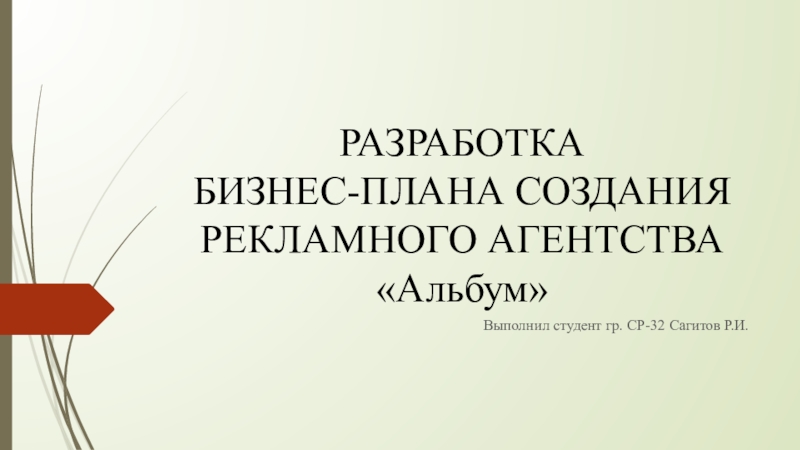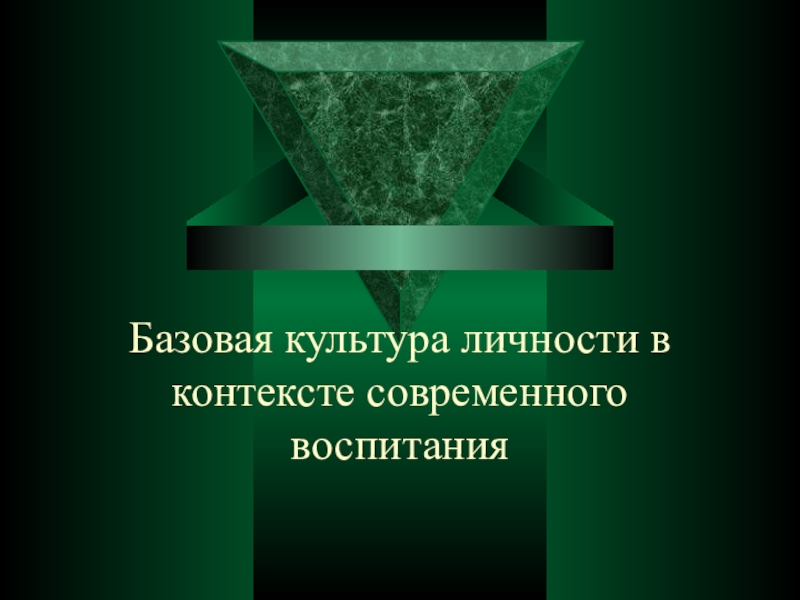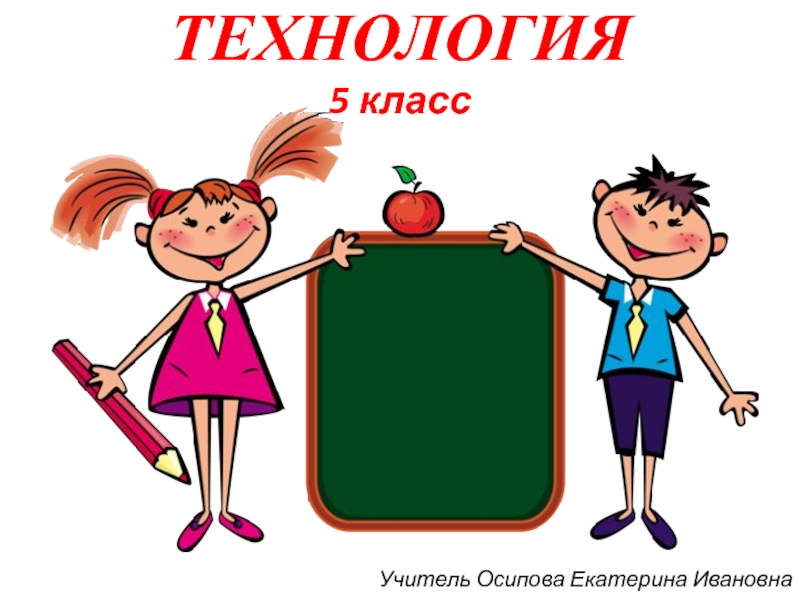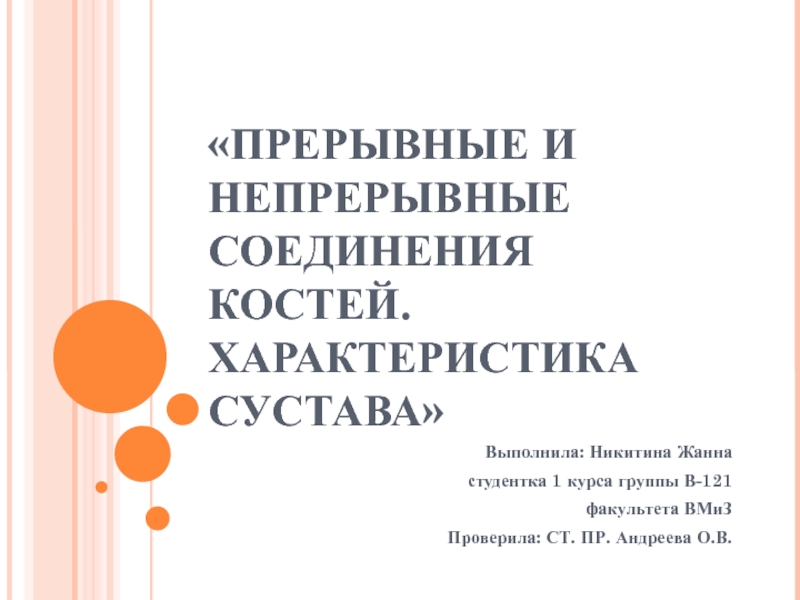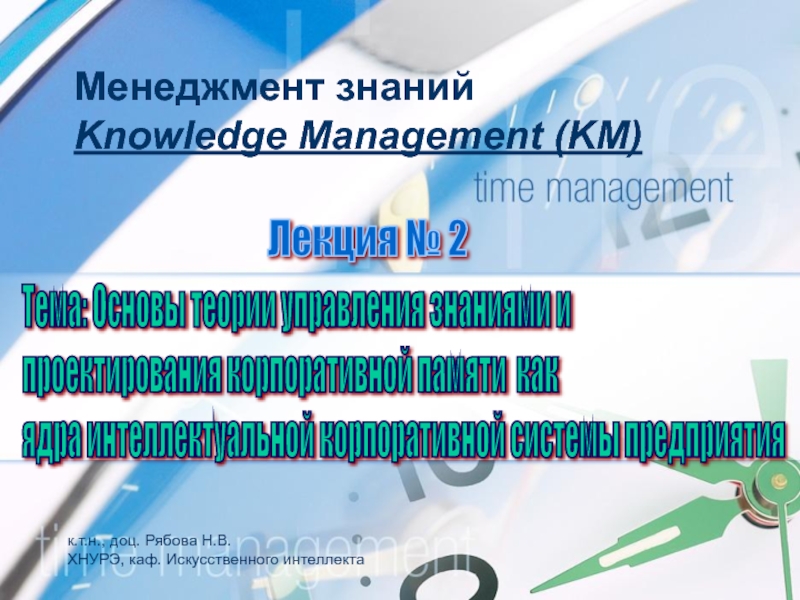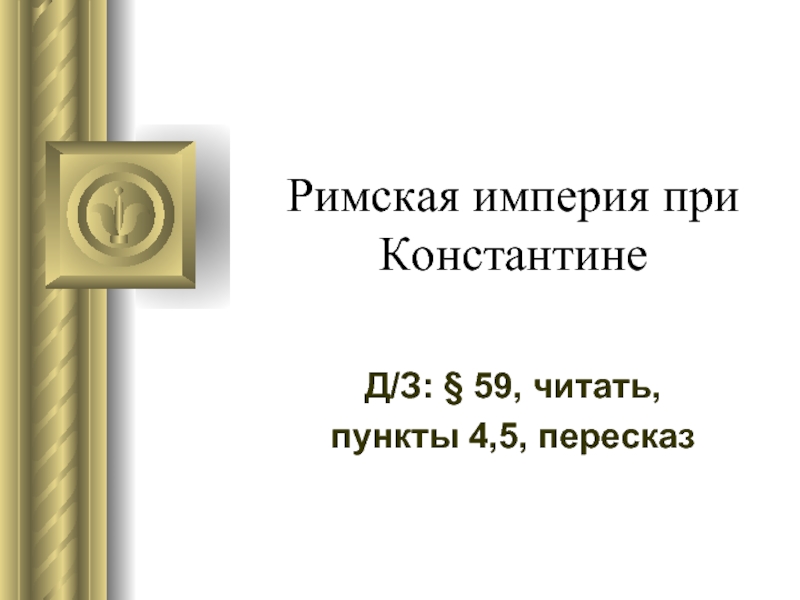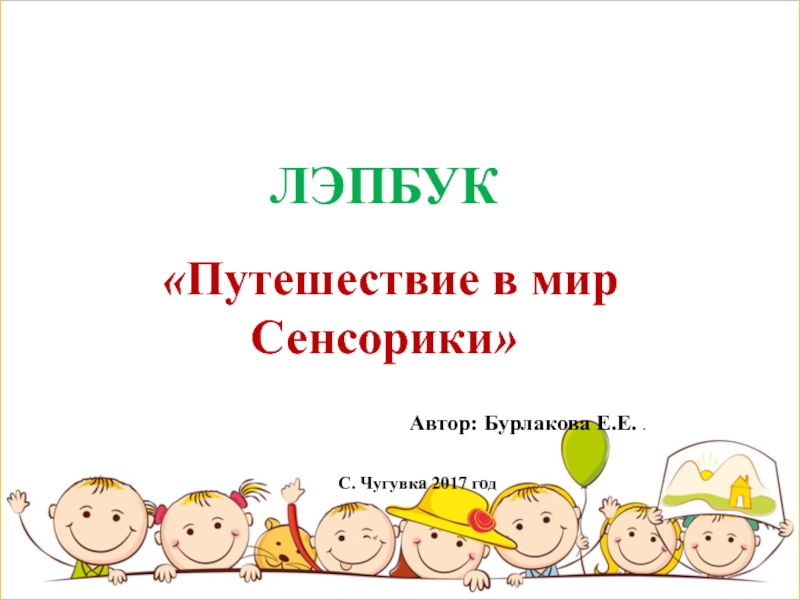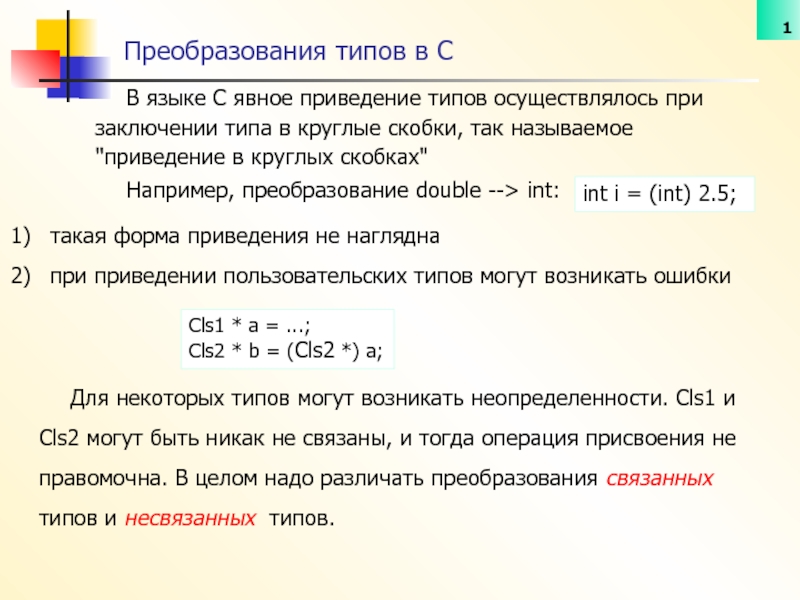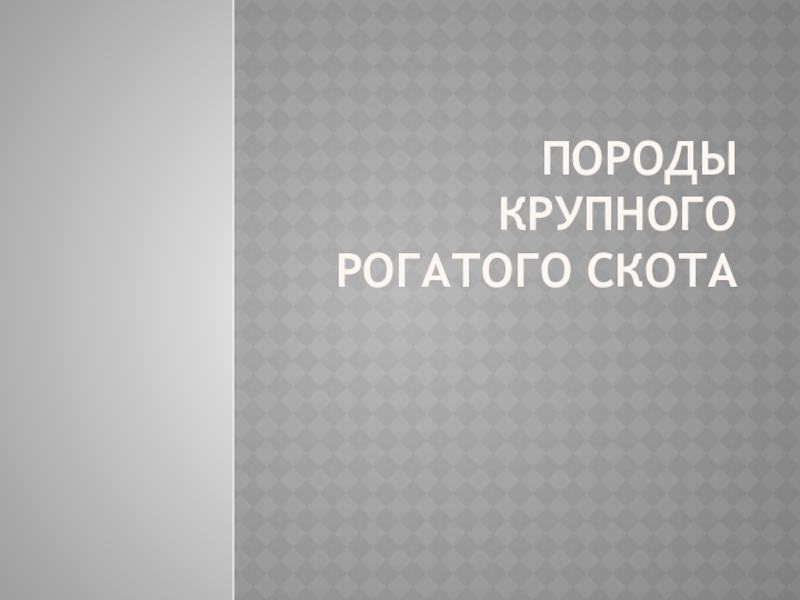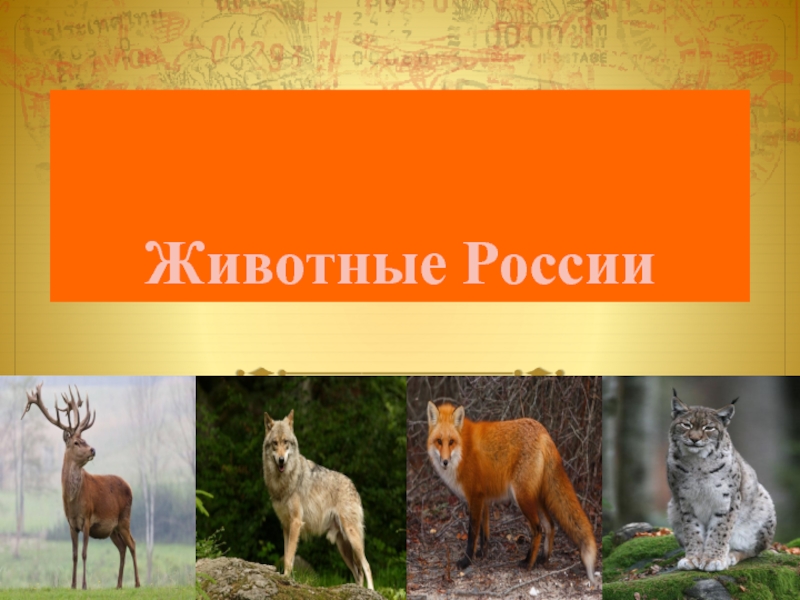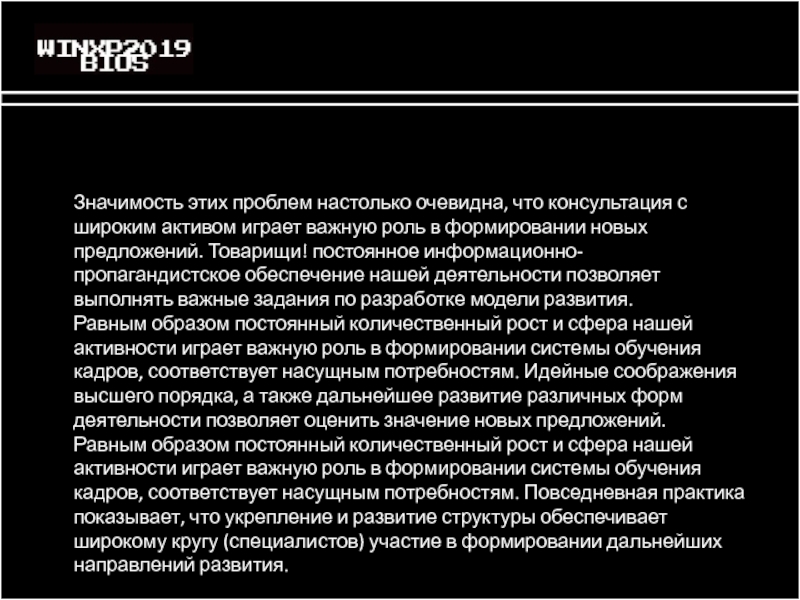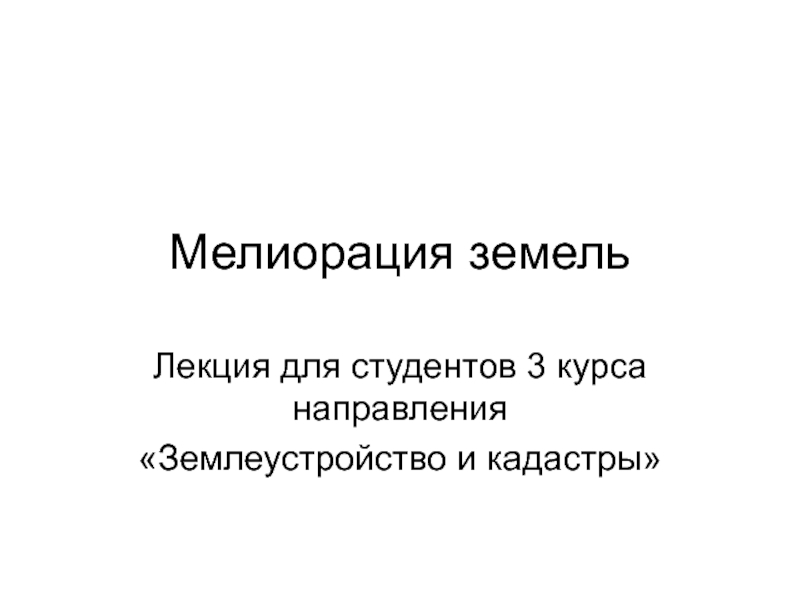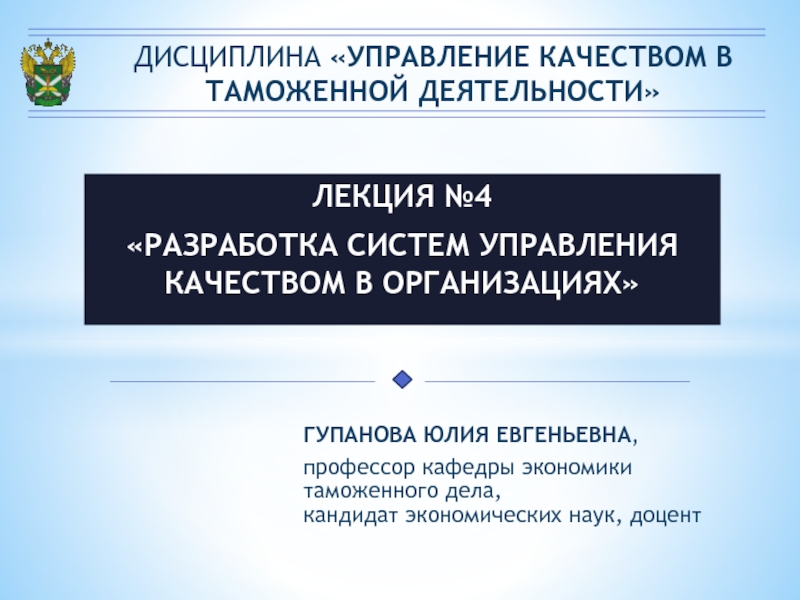Разделы презентаций
- Разное
- Английский язык
- Астрономия
- Алгебра
- Биология
- География
- Геометрия
- Детские презентации
- Информатика
- История
- Литература
- Математика
- Медицина
- Менеджмент
- Музыка
- МХК
- Немецкий язык
- ОБЖ
- Обществознание
- Окружающий мир
- Педагогика
- Русский язык
- Технология
- Физика
- Философия
- Химия
- Шаблоны, картинки для презентаций
- Экология
- Экономика
- Юриспруденция
A BRIEF HISTORY OF THE NOVEL
Содержание
- 1. A BRIEF HISTORY OF THE NOVEL
- 2. GENERAL PARAMETERS OF THE NOVEL GENRE: Fiction:
- 3. Verisimilitudea semblance of truthrecognizable settings and characters
- 4. Narrative Precursors to the NovelHeroic Epics Gilgamesh,
- 5. Narrative Precursors to the NovelMedieval European Romances
- 6. The First NovelsThe Tale of Genji (
- 7. Types of Novels Picaresque Epistolary Sentimental Gothic
- 8. The Tale of Genji Lady MurasakiPicture of
- 9. Heian Japan794-1185Capital at Heian: present-day Kyoto Highly
- 10. Heian LiteratureMen continued to write Chinese-style poetryWomen
- 11. Ming Dynasty 1368-1644Founded by Chu Yuan-chang, a
- 12. Ming Literature Development of the
- 13. Don Quixote by Miguel de Cervantes
- 14. The Princess of Cleves Madame de Lafayette
- 15. The Rise of the English NovelThe Restoration
- 16. England’s first professional female author: Aphra
- 17. Daniel DefoeMaster of plain prose and powerful
- 18. Picaresque NovelsDerives from Spanish picaro: a rogueA
- 19. Epistolary NovelsNovels in which the narrative is
- 20. Fathers of the English Novel Pamela (1740)
- 21. Jane Austen and the Novel of
- 22. Gothic NovelsNovels characterized by magic, mystery and
- 23. Frankenstein by Mary Shelley 1797-1851Inspired by
- 24. Novels of SentimentNovels in which the characters,
- 25. The Brontës Charlotte (1816-55), Emily (1818-48), Anne
- 26. Historical NovelsNovels that reconstruct a past age,
- 27. Realism and NaturalismMiddle classPragmaticPsychological
- 28. Social RealismSocial or Sociological novels deal with
- 29. Charles Dickens 1812-1870By including varieties of poor
- 30. The Russian NovelRussia from 1850-1920 was a
- 31. The Russian NovelEven beyond their deaths, the
- 32. Modernism “Modernism” designates an international artistic
- 33. Stream of ConsciousnessNarration that mimics the ebb
- 34. Post-Modernism“Postmodernism” is widely used to define contemporary
- 35. Magical Realism Latin American “Boom”“A worldwide twentieth-century
- 36. Magical Realism Post-Colonial LiteratureAn exploration of the
- 37. Internet LinksAn Introduction to the Novel The Novel TimelineBibliomania’s History of the NovelBecoming a Modern Reader
- 38. Скачать презентанцию
Слайды и текст этой презентации
Слайд 2GENERAL PARAMETERS OF THE NOVEL
GENRE: Fiction: Narrative
STYLE: Prose
LENGTH: Extended
real life and manners, and of the time in which it is written. The Romance, in lofty and elevated language, describes what never happened nor is likely to happen.” Clara Reeve, The Progress of Romance, 1785Слайд 3Verisimilitude
a semblance of truth
recognizable settings and characters in real time
what
Hazlitt calls, “ the close imitation of men and manners…
the very texture of society as it really exists.”The novel emerged when authors fused adventure and romance with verisimilitude and heroes that were not supermen but ordinary people, often, insignificant nobodies.
Слайд 4Narrative Precursors to the Novel
Heroic Epics
Gilgamesh, Homer’s Iliad and Odyssey,
Mahabharata, Valmiki’s Ramayana, Virgil’s Aeneid, Beowulf, The Song of Roland
Ancient Greek and Roman Romances and Novels An Ephesian Tale and Chaereas and Callirhoe, Petronius’s, Satyricon, Apuleius’s The Golden Ass
Oriental Frame Tales The Jataka, A Thousand and One Nights
Irish and Icelandic Sagas The Tain bo Cuailinge, Njal’s Saga
Слайд 5Narrative Precursors to the Novel
Medieval European Romances
Arthurian tales culminating in
Malory’s Morte Darthur
Elizabethan Prose Fiction
Gascoigne’s The Adventure of Master F.
J.,Lyly’s Euphues, Greene’s Pandosto: The Triumph of Time, Nashe’s The Unfortunate Traveller, Deloney’s Jack of NewburyTravel Adventures Marco Polo, Ibn Batuta, More’s Utopia, Swift’s Gulliver’s Travels, Voltaire’s Candide
Novelle Boccaccio’s Decameron, Margurerite de Navarre’s Heptameron
Moral Tales Bunyan’s Pilgrim’s Progess, Johnson’s Rasselas
Слайд 6The First Novels
The Tale of Genji ( Japan, 11th c.
)by Lady Murasaki Shikibu
Monkey, Water Margin, and Romance of Three
Kingdoms (China, 16th c.)Don Quixote ( Spain, 1605-15) by Miguel de Cervantes
The Princess of Cleves (France, 1678) by Madame de Lafayette
Love Letters between a Nobleman and His Sister (England, 1683) and Oroonoko (1688)by Aphra Behn
Robinson Crusoe (England, 1719) , Moll Flanders (1722) and A Journal of the Plague Year (1722) by Daniel DeFoe
Pamela, or Virtue Rewarded (England, 1740-1742) by Samuel Richardson
Joseph Andrews (England, 1742) and Tom Jones (1746)by Henry Fielding
Слайд 7Types of Novels
Picaresque
Epistolary
Sentimental
Gothic
Historical
Psychological
Realistic/Naturalistic
Regional
Social
AdventureMystery
Science Fiction
Magical Realism
Слайд 8The Tale of Genji
Lady Murasaki
Picture of life at the 10th
c. Heian court
Relates the lives and loves of Prince Genji
and his children and grandchildrenUnesco Global Heritage Pavilion: The Tale of Genji
Слайд 9Heian Japan
794-1185
Capital at Heian: present-day Kyoto
Highly formalized court culture
Aristocratic
monopoly of power
Literary and artistic flowering
Ended in civil war with
civil wars and emergence of samurai cultureСлайд 10Heian Literature
Men continued to write Chinese-style poetry
Women began to write
in Japanese prose
First novel: Genji Monogatari by Lady Murasaki Shikibu
Diaries:
The
Pillowbook by Sei ShonaganAs I Crossed a Bridge of Dreams? by Lady Sarashina
The Tosa Diary
Слайд 11Ming Dynasty 1368-1644
Founded by Chu Yuan-chang, a peasant who had
been a Buddhist monk, a bandit leader and a rebel
general – Emperor Hong WuLast native imperial dynasty in Chinese history
Re-adopted civil-service examination system
One of China’s most prosperous periods: agricultural revolution, reforestation, manufacturing and urbanization
Слайд 12Ming Literature
Development of the novel
Arose from traditions
of Chinese storytelling
Written in commoner’s language
Divided into chapters at points
where storytellers would have stopped to collect moneyClassics of Chinese literature:
Water Margin, 16th c. – band of outlaws
Romance of Three Kingdoms, 16th c. – historical novel
Monkey: Journey to the West, 16th-17th c.
Слайд 13Don Quixote
by Miguel de Cervantes
(1547-1616)
First European novel: part I
- 1605; part II - 1615
A psychological portrait of a
mid-life crisisSatirizes medieval romances, incorporates pastoral, picaresque, social and religious commentary
What is the nature of reality?
How does one create a life?
The Cervantes Project
Слайд 14The Princess of Cleves
Madame de Lafayette
1634-93
First European historical novel –
recreates life of 16th c. French nobility at the court
of Henri IIFirst roman d'analyse (novel of analysis), dissecting emotions and attitudes
Study guide for the The Princess of Cleves
Слайд 15The Rise of the English Novel
The Restoration of the monarchy
(1660) in England after the Puritan Commonwealth (1649-1660) encouraged an
outpouring of secular literatureAppearance of periodical literature: journals and newspapers
Literary Criticism
Character Sketches
Political Discussion
Philosophical Ideas
Increased leisure time for middle class: Coffee House and Salon society
Growing audience of literate women
England in the 17th and 18th Centuries
Слайд 16England’s first
professional female author:
Aphra Behn
1640-1689
Novels
Love Letters between a
Nobleman and his sister (1683)
The Fair Jilt (1688)
Agnes
de Castro (1688)Oroonoko (c.1688)
Drama
The Forced Marriage (1670)
The Amorous Prince (1671)
Abdelazar (1676)
The Rover (1677-81)
The Feign'd Curtezans (1679)
The City Heiress (1682)
The Lucky Chance (1686)
The Lover's Watch (1686)
The Emperor of the Moon (1687)
Lycidus (1688)
Слайд 17Daniel Defoe
Master of plain prose and powerful narrative
Reportial: highly realistic
detail
Travel adventure: Robinson Crusoe, 1719
Contemporary chronicle: Journal of the Plague
Year , 1722 Picaresques: Moll Flanders, 1722 and Roxana
Слайд 18Picaresque Novels
Derives from Spanish picaro: a rogue
A usually autobiographical chronicle
of a rascal’s travels and adventures as s/he makes his/her
way through the world more by wits than industryEpisodic, loose structure
Highly realistic: detailed description and uninhibited expression
Satire of social classes
Contemporary picaresques: Saul Bellow’s Adventures of Augie March; Jack Kerouac’s On the Road
Слайд 19Epistolary Novels
Novels in which the narrative is told in letters
by one or more of the characters
Allows author to present
feelings and reactions of characters, brings immediacy to the plot, allows multiple points of viewPsychological realism
Contemporary epistolary novels: Alice Walker’s The Color Purple; Nick Bantock’s Griffin and Sabine; Kalisha Buckhannon’s Upstate
Слайд 20Fathers of the English Novel
Pamela (1740) and Clarissa (1747-48)
Epistolary
Sentimental
Morality tale: Servant resisting seduction by her
employer Shamela (1741) Joseph Andrews (1742), and Tom Jones (1749)
Picaresque protagonists
“comic epic in prose”
Parody of Richardson
Samuel Richardson
1689-1761
Henry Fielding
1707-1754
Слайд 21Jane Austen and
the Novel of Manners
Novels dominated by the
customs, manners, conventional behavior and habits of a particular social
classOften concerned with courtship and marriage
Realistic and sometimes satiric
Focus on domestic society rather than the larger world
Other novelists of manners: Anthony Trollope, Edith Wharton, F. Scott Fitzgerald, Margaret Drabble
Слайд 22Gothic Novels
Novels characterized by magic, mystery and horror
Exotic settings –
medieval, Oriental, etc.
Originated with Horace Walpole’s Castle of Otranto (1764)
William
Beckford: Vathek, An Arabian Tale (1786)Anne Radcliffe: 5 novels (1789-97) including The Mysteries of Udolpho
Widely popular genre throughout Europe and America: Charles Brockden Brown’s Wieland (1798)
Contemporary Gothic novelists include Anne Rice and Stephen King
Слайд 23Frankenstein
by Mary Shelley
1797-1851
Inspired by a dream in reaction to
a challenge to write a ghost
story
Published in 1817
(rev.
ed. 1831)A Gothic novel influenced by Promethean myth
The first science fiction novel
Слайд 24Novels of Sentiment
Novels in which the characters, and thus the
readers, have a heightened emotional response to events
Connected to emerging
Romantic movementLaurence Sterne (1713-1768): Tristam Shandy (1760-67)
Johann Wolfgang von Goethe (1749-1832): The Sorrows of Young Werther (1774)
Francois Rene de Chateaubriand (1768-1848): Atala (1801) and Rene (1802)
The Brontës: Anne Brontë Agnes Grey (1847) Emily Brontë, Wuthering Heights (1847), Charlotte Brontë, Jane Eyre (1847)
Слайд 25The Brontës
Charlotte (1816-55), Emily (1818-48), Anne (1820-49)
Wuthering Heights and Jane
Eyre transcend sentiment into myth-making
Wuthering Heights plumbs the psychic unconscious
in a search for wholeness, while Jane Eyre narrates the female quest for individuationBrontë.info: website of Brontë Society and Haworth Parsonage
The Victorian Web
portrait by Branwell Brontë of his sisters,
Anne, Emily, and Charlotte (c. 1834)
Слайд 26Historical Novels
Novels that reconstruct a past age, often when two
cultures are in conflict
Fictional characters interact with with historical figures
in actual eventsSir Walter Scott (1771-1832) is considered the father of the historical novel: The Waverly Novels (1814-1819) and Ivanhoe (1819)
Слайд 27Realism and Naturalism
Middle class
Pragmatic
Psychological
Mimetic art
Objective, but
ethical
Sometimes comic or satiric
How can the individual live within and
influence society?Honore Balzac, Gustave Flaubert, George Eliot, William Dean Howells, Mark Twain, Leo Tolstoy, George Sand
Middle/Lower class
Scientific
Sociological
Investigative art
Objective and amoral
Often pessimistic, sometimes comic
How does society/the environment impact individuals?
Emile Zola, Fyodor Dostoevsky, Thomas Hardy, Stephen Crane, Theodore Dreiser
Слайд 28Social Realism
Social or Sociological novels deal with the nature, function
and effect of the society which the characters inhabit –
often for the purpose of effecting reformSocial issues came to the forefront with the condition of laborers in the Industrial Revolution and later in the Depression: Dickens’ Hard Times, Gaskell’s Mary Barton; Eliot’s Middlemarch; Steinbeck’s Grapes of Wrath
Slavery and race issues arose in American social novels: Stowe’s Uncle Tom’s Cabin, 20th c. novels by Wright, Ellison, etc.
Muckrakers exposed corruption in industry and society: Sinclair’s The Jungle, Steinbeck’s Cannery Row
Propaganda novels advocate a doctrinaire solution to social problems: Godwin’s Things as They Are, Rand’s Atlas Shrugged
Слайд 29Charles Dickens
1812-1870
By including varieties of poor people in all his
novels, Dickens brought the problems of poverty to the attention
of his readers:“It is scarcely conceivable that anyone should…exert a stronger social influence than Mr. Dickens has…. His sympathies are on the side of the suffering and the frail; and this makes him the idol of those who suffer, from whatever cause.” Harriet Martineau
The London Times called him "pre-eminently a writer of the people and for the people . . . the 'Great Commoner' of English fiction."
Dickens aimed at arousing the conscience of his age. To his success in doing so, a Nonconformist preacher paid the following tribute: "There have been at work among us three great social agencies: the London City Mission; the novels of Mr. Dickens; the cholera."
The Dickens Project, The Dickens Page
"Dickens' Social Background" by E. D. H. Johnson
Слайд 30The Russian Novel
Russia from 1850-1920 was a period of social,
political, and existential struggle.
Writers and thinkers remained divided: some
tried to incite revolution, while others romanticized the past as a time of harmonious order. The novel in Russia embodied these struggles and conflicts in some of the greatest books ever written.
The characters in the works search for meaning in an uncertain world, while the novelists who created them experiment with modes of artistic expression to represent the troubled spirit of their age.
Слайд 31The Russian Novel
Even beyond their deaths, the two novelists stand
in contrariety… Tolstoy, the mind intoxicated with reason and fact;
Dostoevsky, the contemner of rationalism, the great lover of paradox; …Tolstoy, thirsting for the truth, destroying himself and those about him in excessive pursuit of it; Dostoevsky, rather against the truth than against Christ, suspicious of total understanding and on the side of mystery; …Tolstoy, like a colossus bestriding the palpable earth, evoking the realness, the tangibility, the sensible entirety of concrete experience; Dostoevsky, always on the verge of the hallucinatory, of the spectral, always vulnerable to daemonic intrusions into what might prove, in the end, to have been merely a tissue of dreams; ~ George Steiner in Tolstoy or Dostoevsky: An Essay in the Old Criticism (1959)Fyodor Dostoevsky
1821-1881
The Gambler
Crime and
Punishment
Notes from Underground
The Brothers Karamazov
Leo Tolstoy
1828-1910
The Cossacks
Anna Karenina
War and Peace
Resurrection
Слайд 32
Modernism
“Modernism” designates an international artistic movement, flourishing from the 1880s
to the end of WW II (1945), known for radical
experimentation and rejection of the old order of civilization and 19th century optimism; a reaction against Realism and Naturalism“Modern” implies historical discontinuity, a sense of alienation, loss and despair – angst -- a loss of confidence that there exists a reliable, knowable ground of value and identity.
Horrors of WW I (1914-1918)
Modernism; Some Cultural Forces Driving Literary Modernism; Attributes of Modernist Literature; Modernism and the Modern Novel
On or about December 1910, the world changed.” -- Virginia Woolf
Слайд 33Stream of Consciousness
Narration that mimics the ebb and flow of
thoughts of the waking mind
Uninhibited by grammar, syntax or logical
transitionsA mixture of all levels of awareness – sensations, thoughts, memories, associations, reflections
Emphasis on how something is perceived rather than on what is perceived
James Joyce, Dorothy Richardson, Virginia Woolf, Thomas Wolfe, William Faulkner
James Joyce
1882-1941
The Dubliners
Portrait of an Artist
Ulysses
Finnegan’s Wake
Virginia Woolf
1882-1941
To the LightHouse
The Waves
Mrs. Dalloway
Orlando
Слайд 34Post-Modernism
“Postmodernism” is widely used to define contemporary (post-1970s) culture, technology
and art – an age transformed by information technology, shaped
by electronic images and fascinated with popular art.Rejects the elitism and difficulty of Modernism
Postmodernism celebrates the idea of fragmentation, provisionality, or incoherence. “The world is meaningless? Let's not pretend that art can make meaning then, let's just play with nonsense.”
Emphasis on reflexivity – fictions about fiction -- metafiction
Postmodernism; Some Attributes of Post-Modern Literature
Слайд 35Magical Realism
Latin American “Boom”
“A worldwide twentieth-century tendency in the graphic
and literary arts…. The frame of surface of he work
may be conventionally realistic, but contrasting elements – such as the supernatural, myth dream, fantasy – invade the realism and change the whole basis of the art.” Harmon and HolmanLatin American literary “Boom” began in the 1950s: Jorge Luis Borges, Carlos Fuentes, Gabriel Garcia Marquez, Jose Donoso, Mario Vargas Llosa
“ The authors involved are resolutely engaged in a transfiguration of Latin American reality, from localism to a kind of heightened, imaginative view of what is real--a universality gained by the most intense and luminous kind of locality.” Alexander Coleman
Слайд 36Magical Realism
Post-Colonial Literature
An exploration of the encounter of different cultures,
world views, and perceptions of reality. What is absolutely ordinary
and "real" to one culture, is "magical" to the other culture.From a "Western" viewpoint, the other culture's reality is often described as superstition, witchcraft or nonsense.
From another culture's viewpoint (Native American, African American, Eastern, African, etc.) western logic and science are viewed as "magic" or disconnected from the spiritual world.
The intersect of these different world views is Magical Realism.
Magical Realism Links
